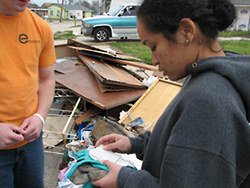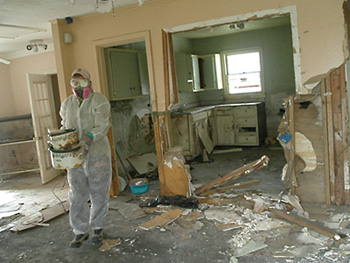Princeton University
Princeton Weekly Bulletin March 12, 2007, Vol. 96, No. 19 prev next current
- Page One
- • Testing the boundaries of teaching science
- • Harris-Lacewell draws on intellectual prowess and common sense
- Inside
- • Energy plant wins award for reducing pollution and improving efficiency
- • Film about senior thesis performance earns honors
- • Students turn class into effort to help New Orleans rebuild
- • Exhibition, panel to document socialist architecture in Eastern Europe
- People
- • Spotlight
- Almanac
- • Calendar of events
- • Nassau notes
- • By the numbers
- The Bulletin is published weekly during the academic year, except during University breaks and exam weeks, by the Office of Communications. Second class postage paid at Princeton. Postmaster: Send address changes to Princeton Weekly Bulletin, Office of Communications, Princeton University, 22 Chambers St., Suite 201, Princeton, NJ 08542. Permission is given to adapt, reprint or excerpt material from the Bulletin for use in other media.
- Subscriptions. The Bulletin is distributed free to faculty, staff and students. Others may subscribe to the Bulletin for $30 for the 2006-07 academic year (half price for current Princeton parents and people over 65). Send a check to Office of Communications, Princeton University, 22 Chambers St., Suite 201, Princeton, NJ 08542.
- Deadlines. In general, the copy deadline for each issue is the Friday 10 days in advance of the Monday cover date. The deadline for the Bulletin that covers March 26-April 1 is Friday, March 16. A complete publication schedule is available at www.princeton.edu/ pr/ pwb/ deadlines.html; or by calling (609) 258-3601.
- Editor: Ruth Stevens Calendar editor: Shani Hilton Staff writers: Jennifer Greenstein Altmann, Eric Quiñones Contributing writers: Ushma Patel Photographers: Denise Applewhite, John Jameson Design: Maggie Westergaard Web edition: Mahlon Lovett
Got guts?
Students turn class into effort to help New Orleans rebuild
Princeton NJ — University sophomore Emery Whalen was gutting a home in New Orleans during intersession when she found treasure buried in the trash heap.
A cache of family photos poked out, and Whalen and classmate Farrell Harding began searching for salvageable pictures that could be returned to the homeowners. Their classmates gathered around, some crying as they thought of the lives that had been uprooted.

The students helped gut four homes in New Orleans. At one of the homes, senior Aitalohi Amaize found a family member’s Bible study notes among the debris left behind. {photo: Veneka Chagwedera)
“The first few days the houses had been already cleaned out by other people and so it was just a structure we were ripping apart,” said Whalen, a New Orleans native. “It was really great for the people on the trip to realize that there’s a much more human aspect to it.”
During the trip from Jan. 28 to Feb. 3, 13 Princeton students gutted houses by day and met with city leaders and residents by night. By enhancing their understanding of the complex issues around rebuilding New Orleans following 2005’s Hurricane Katrina, the undergraduates produced several proposals to bring attention and aid to the still-devastated city.
Students initiated the trip during the course, “Disaster, Race and American Politics,” taught last fall by associate professor of politics and African American studies Melissa Harris-Lacewell. The class examined the factors that shaped the disaster, its media coverage and American attitudes about it, Harris-Lacewell said.
“I started the class by talking about a bunch of interviews I had done while I was in New Orleans, and there was almost a consensus among African American survivors that the government had … purposely destroyed the levees in order to flood the Lower Ninth Ward,” she said. “I don’t care if that’s true. What I care about is that there’s an entire population of U.S. citizens that believe it’s true. … Our work is to figure out what are the implications.”
For her students, however, talking about the issues was insufficient. They wanted to make a measurable difference.
Senior Aitalohi Amaize, who had coordinated trips for the Student Volunteers Council, began hammering out the logistics, from contacting community organizations on the ground to setting up lodging at a Salvation Army shelter. With Harris-Lacewell’s help, the group obtained funding from the Center for African American Studies, the Pace Center and the Bobst Center for Peace and Justice.
In New Orleans, the group worked with the Association of Community Organizations for Reform Now (ACORN), which has a list of thousands of people who need help rebuilding their homes. Students had to wear protective suits and respirators while working because of mold and other pollutants.
Senior Conrad Legendy was not in Harris-Lacewell’s course but signed up for the trip to conduct research for his senior thesis, which in part will compare attitudes toward reconstruction in New Orleans and in Kabul, Afghanistan. He was shocked that so many homes in New Orleans were still in such poor condition, despite the resources of the United States.
When trying to pry a doorframe off with a crowbar, his arm went through a wall.
“Those houses were on the verge of collapsing,” Legendy said.
Students also saw signs of optimism, such as tidy parks within devastated neighborhoods or tongue-in-cheek graffiti on crumbling homes, Amaize said.
“You see the human spirit, so much more than what you can ever read in a book,” Amaize said.

The students had to wear protective suits and respirators while clearing out the houses, due to mold and other pollutants that had festered since the storm. They removed household effects and then the moldy drywall and rotted wood to make the homes fit for rebuilding. Here, senior Jennifer Scott carries two pots from the kitchen to the curb. (photo: Conrad Legendy)
Harris-Lacewell helped the students schedule meetings with Don Marshall, the director of the New Orleans Jazz & Heritage Festival; Princeton alumna Dr. Evangeline Franklin, the city’s director of clinical health services and employee health; State Sen. Ann Duplessis; Dillard University students; and local families.
Through those discussions, students began to see the overwhelming scope of the city’s problems. Though services such as electricity and running water were restored in most areas, once-vibrant neighborhoods were deserted, with few churches, grocery stores and schools open.
“Where do you start?” Amaize said. “It’s frustrating in a way, but if no one’s going to try to tackle it, nothing’s ever going to get done.”
In fact, the government seemed invisible, Whalen said.
“It was hard to see the response is totally grassroots. ACORN is a grassroots organization,” she said. “The lunches we had were church lunches.”
The students’ answer was to develop several proposals. One is a campaign called “Got Guts?”— a challenge to politicians to come to New Orleans and gut one house, to experience Katrina in an emotional and physical way.
The experience, Legendy said, will let policymakers “walk in the shoes not only of the people you’re not helping enough, but the people who actually are trying to help.” They’ve set up a website, www.wegotguts.com, to promote their efforts.
Also, because the students had such a difficult time coordinating the logistics of their trip, they have added helpful links for prospective volunteers on their website.
The proposals are providing a way for the students to continue their service to New Orleans though they’re back on campus.
“We need to do something to really institutionalize volunteering in New Orleans and really get it going,” Whalen said, “and remind the nation that it’s still an issue.”

